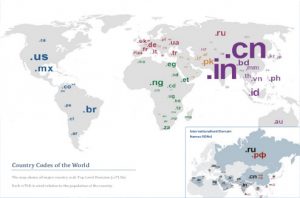Country Code Top Level Domains


Date: 01/02/1981
A country code top-level domain (ccTLD) is an Internet top-level domain generally used or reserved for a country, sovereign state, or dependent territory identified with a country code. All ASCII ccTLD identifiers are two letters long, and all two-letter top-level domains are ccTLDs. In 2010, the Internet Assigned Numbers Authority (IANA) began implementing internationalized country code top-level domains, consisting of language-native characters when displayed in an end-user application. Creation and delegation of ccTLDs is described in RFC 1591, corresponding to ISO 3166-1 alpha-2 country codes.
When the Domain Name System was created in the 1980s,the domain name space was divided into two main groups of domains. The country code top-level domains (ccTLD) were primarily based on the two-character territory codes of ISO-3166 country abbreviations. In addition, a group of seven generic top-level domains (gTLD) was implemented which represented a set of categories of names and multi-organizations. These were the domains GOV, EDU,COM, MIL, ORG, NET, and INT.
Implementation
The implementation of ccTLDs was started by IANA. The delegation and creation of ccTLDs is presented within RFC 1591. In order to determine whether new ccTLDs should be added or not, the IANA follows the provisions of ISO 3166 – Maintenance Agency.
IANA’s Procedures for ccTLDs
Within its database, IANA contains authoritative information related to ccTLDs, referring to sponsoring organizations, technical and administrative contacts, name servers, registration URLs and other such information. This type of information provides extra details regarding the IANA’s procedures for maintaining the ccTLD database.
Delegation and Redelegation
The process through which the designated manager, or managers, is changed is know as redelegation. The process follows the provisions of ICP-1 and RFC 1591. IANA receives all requests of a sponsoring organization related to delegation and redelegation for the ccTLDs. The requests are then analyzed by IANA based on various technical and public criterion, and finally sent to the ICANN Board of Directors for approval or refusal. If approved, IANA is also responsible for the implementation of the request.
Conceptually speaking, the delegation and redelegation processes are simple, but can easily become complex if there are many organizations and individuals involved in the process. There is a set of steps that must be followed before sending the request for delegation or redelegation. An initial request should be developed based on The Change Request Template and supplementary information to prove that the eligibility criteria has been met by the initial request. All the information supplied is used by IANA to fortify the request received.
ccTLDs and ICANN
The policies developed by ICANN are implemented by gTLD registry operators, ccTLD managers, root-nameserver operators and regional Internet registries. One of the main activities of ICANN is to work with other organizations involved in the technical coordination of the Internet with the purpose of formally documenting their participatory role within the ICANN process. These organizations are committed to the ICANN policies that result from their work. Starting in 2000, ICANN started cooperating with ccTLD managers to document their relationship. Due to various circumstances such as: the type of organization, cultural issues, economics, the legal environment, etc., the relationships between ICANN and ccTLD mangers are often complex. Another consideration is the role of the national government in “managing or establishing policy for their own ccTLD” (role recognized in the June 1998, U.S. Government White Paper). In 2009, ICANN began the implementation of an IDN ccTLD Fast Track Process, whereby countries that use non-Latin script are able to claim ccTLDs in their native script and the corresponding Latin version. As of early 2011, 33 requests have been received, representing 22 languages. More than half have already been approved.